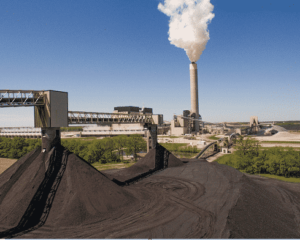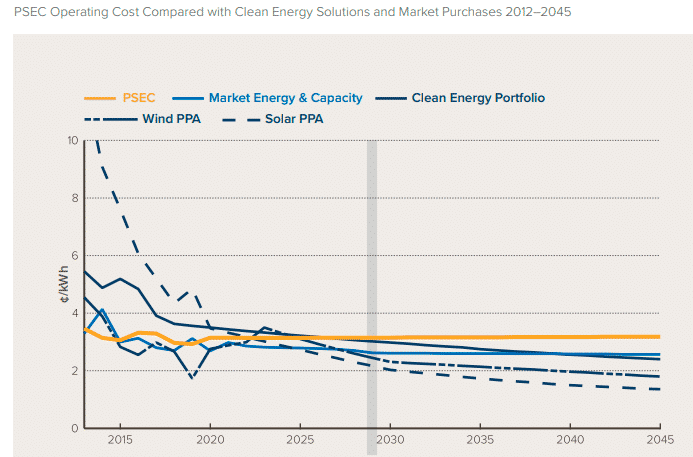Four False Claims about Illinois’ Biggest Polluter, the Prairie State Coal Plant
The Prairie State plant, a 1,766 megawatt behemoth located just 36 miles southeast of St Louis, is the largest coal-fired power plant and the largest carbon emitter in Illinois. Prairie State’s pollution, along with its unique ownership structure and relatively young age, have put it in the middle of state and national conversations about decarbonizing our power sector.

(Photo credit: U.S. Department of Energy)
Prairie State is owned by nine public power agencies that serve 277 municipal utilities and rural electric cooperatives across 8 states (Find out if your Illinois municipality or Rural Electric Cooperative gets its power from Prairie State here). Around 2007, communities across the Midwest were sold on the idea of Prairie State as a way to get cheap energy – and they took on massive debt to pay for the construction of the power plant. The promise of cheap energy has not been realized, but the debt is very real. As long as the plant remains open, captive ratepayers must continue to buy their energy from Prairie State, no matter the high cost and threat to public health and the planet.
An omnibus energy bill being negotiated in Springfield has an opportunity to tackle climate change and close Prairie State by 2035 through regulations on air pollution. The bill would also create programs to support the communities and workers impacted by the transition away from coal. In opposition to this effort, proponents of the plant are falsely calling Illinois’ biggest carbon emitter the “cleanest coal plant in the nation!” In this blog post, we tackle this and other false claims about the plant.
False Claim #1: “The Prairie State coal plant is one of the cleanest coal-fired power plants in the nation.”
The Better Government Association recently fact-checked this claim in detail, stating “While experts say there are multiple ways to evaluate which coal plants are the “cleanest”…Prairie State ranked nowhere near the top based on any of the yardsticks we found to measure it.”

The Prairie State coal plant is the top emitter of planet-warming greenhouse gases in Illinois, and one of the ten largest in the U.S. Additionally, Prairie State emits more toxic sulfur dioxide and nitrogen oxides than any source in Illinois. These toxic pollutants and others generated at the power plant contribute to the cause of 76 premature deaths/year.
Those touting the claims of “clean coal” often conveniently forget about coal ash and the entire dirty mining process for coal. Prairie State dumps its coal ash in a massive, 750-acre coal ash landfill known as the “Near Field Facility.” The scale is truly massive – 750 acres is larger than a square mile, that is, it is larger than a mile wide and a mile long. The power plant has been in operation for nine years, and the landfill already stores over twenty million cubic yards of coal ash. The amount of coal ash created at this power plant each year (roughly 2.3 million cubic yards) is comparable to the amount created at other power plants over their entire lifespans. By comparison, the Vermilion Power Plant, for example, stores approximately 3 million cubic yards of coal ash after operating for more than five decades.
False Claim #2: “If Prairie State closes, electricity rates will go up and members will have to pay twice for electricity.”
If Prairie State closes, members will not have to keep buying power from it, and renewable power sources are proving cheaper energy than the costs at the Prairie State plant. The Illinois Municipal Electric Agency (IMEA) has made many false claims about the cost of replacing Prairie State, learn more about their incorrect assumptions here.

The cost of solar and wind have declined 67% and 44% respectively since the Prairie State coal plant opened in 2012. According to an analysis by RMI, the cost to generate energy from the plant is higher than the cost to build, own, and operate wind power projects today. Renewable prices are expected to continue to fall, while the cost of operating Prairie State is likely to increase.
Communities are paying the debt associated with building the plant, but they are also paying significant costs to fuel, operate, and maintain the plant. If the plant closes, those operation costs will no longer be borne and the communities would be free to buy power from other cleaner and less expensive sources. The RMI report found that these operation costs, not including the debt related costs, were slightly more than what communities would have paid for the same energy and capacity from market purchases. In other words, it would be cheaper for Prairie State owners to close the plant and purchase cheaper energy elsewhere. Unfortunately, they will still have to pay the debt associated with building the plant, but their overall costs would go down. In fact, the report concluded that by 2030, “closing the plant and replacing it with a clean energy portfolio (CEP) that includes wind, solar, battery storage, demand flexibility, and energy efficiency is expected to save ratepayers money without sacrificing reliability.”
False Claim #3: “We won’t have reliable power if we close the Prairie State coal plant.”
Illinois is already on a path to a reliable power mix that does not include coal. In 2020, 58% of Illinois’ net electricity generation came from nuclear power, with coal dwindling to just 18%. Proposed energy legislation would commit IL to hit 40% renewable energy by 2030. That’s five years before the 2035 proposed closure of Prairie State and 15 years before the proposed closure of 2045 of gas generation.
Integrating more renewables into the grid will absolutely require additional investments in transmission grid planning, energy efficiency, battery storage, and demand response over the next 15-25 years as we transition to a carbon-free future without coal and gas. With utility-scale battery storage costs decreasing nearly 70% between 2015 and 2018, there is every indication that the technology and investments in battery storage can and will happen. Despite the COVID-19 pandemic, 179% more MW of storage was added in 2020 than in 2019 and projections show that the U.S.’s utility-scale battery power is set to grow from 1.2 gigawatts in 2020 to nearly 7.5 gigawatts in 2025 and absolutely skyrocket from there.
False Claim #4: “The closure of Prairie State will result in power being imported from dirty power plants in neighboring states.”
The Prairie State coal plant is the top emitter of planet-warming greenhouse gases in Illinois, and one of the ten largest in the U.S. Additionally, Prairie State emits more toxic sulfur dioxide and nitrogen oxides than any source in Illinois. Illinois is connected to a regional grid that allows us to import and export power when needed, and energy generation across that grid is becoming cleaner each year.
The nation is swiftly shifting away from coal to renewable power generation. Generation from coal-fired power has declined steadily over the last decade, dropping from 45% of total generation in 2010 to just 24% in 2019. The S&P Global Platts Analytics’ North American Electricity Five-year Forecast projects that coal-fired generation will fall to between 15% to 16% by 2026. By 2035 the Midwestern grid is bound to be cleaner as other Midwestern states also announce plans to retire coal plants (MN, MO, IA, KS) and pass legislation to speed the transition to renewables. And that’s not to mention goals and policies at a federal level, like President Biden’s goal to create a carbon pollution-free power sector by 2035, that will also likely drive a nationwide shift to renewable energy.
Under the status quo, the future will bring cheaper, cleaner renewable energy for other states and most Illinois ratepayers, while Prairie State customers face mounting costs from coal-ash-producing, health-harming, and planet-warming coal power. State legislation that mandates closure of Prairie State and invests in new renewable generation in our state is the only way to tackle pollution and climate change and ensure that all Illinoisans have access to a clean, renewable energy future.
Prairie State Power Plant Resources
NRDC Blog Post – Natural Resources Defense Council’s summary of the environmental, climate, and economic considerations.
“Transition Opportunities for Prairie State Energy Campus” – RMI Report.
“Contracts to Burn” – Union of Concerned Scientists report showing Prairie State tops the list of GHG emitters locked into long-term contracts.
Chicago Tribune Article – Michael Hawthorne, January 2021
Prairie State Coal Plant Town Hall – Prairie Rivers Network, April 2021
Archives on Prairie State – Institute for Energy Economics and Financial Analysis







